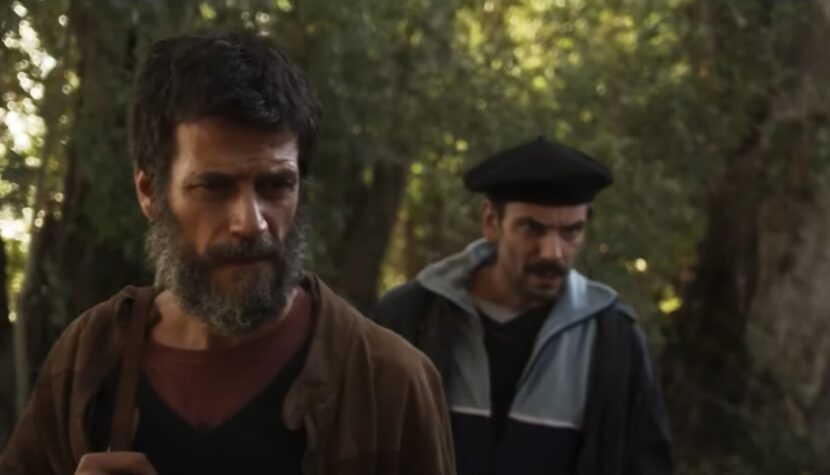WHEN EVIL LURKS, good must die… Rot on the Plantation in Argentina [REVIEW]

“When Evil Lurks,” Demián Rugna’s horror debut premiered at the Toronto Film Festival in the Midnight Madness section. The film caused quite a stir at genre cinema festivals like Sitges in Catalonia, where it won the award for Best Motion Picture. Just before Halloween, the production was made available on the Shudder platform, which is also a co-producer. Six months after its world premiere, the film finally hits Polish theaters, thanks to 9th Plan, a company that has been distributing unconventional and underrated films for 10 years. The picture gained the reputation of the horror of the year. The hype has already been built up, so it’s easy to be disappointed, yet it is such a strong work that it will undoubtedly provide viewers with the impressions they expect from a genuine horror movie.
Two brothers, Pedro (Ezequiel Rodríguez) and Jimi (Demián Salomón), hear shots coming from the nearby forest at night. Concerned, they set out at dawn to investigate and find the mutilated body of a man. The trail leads them to the estate of Maria Elena, where they learn that the murdered man was a “cleaner” sent to kill her son. For a year, the son has been suffering from a terrible disease, swollen, covered in sores, decaying, as if the most dreadful form of cancer had taken root in his body, and all he desires is death. But the problem is, he cannot be killed by firearms—residents believe they are dealing with possession and must adhere to certain rules to prevent Evil from spreading. But Christian prayers or rituals with crosses and holy water are also ineffective. “Churches are dead,” as one of the characters says…

What sets this film apart from a series of classic stories about possession (led by “The Exorcist”) is the departure from the motif of the struggle between good and evil, where on one side are followers of the Christian God, and on the other – demons from hell. Demián Rugna shows that when Evil arises, good must die. Interestingly, his inspiration was the wave of cancer cases in Argentina resulting from the use of glyphosate to spray soybean plantations. Carcinogenic pesticides were sprayed to destroy pests, but they also turned out to be a threat to human health and life. The director framed this contemporary problem with elements of supernatural horror, creating both a shocker and a folk tragedy about the unequal struggle of man against much stronger opponents. And on the opposite side, besides an unknown force with supernatural abilities, there is also the soullessness of governmental institutions that we all know. Soybean plantations bring substantial income to the state, so it is in the authorities’ interest to cover up issues that could harm them.
Since the film has already gained quite a large fan base, the Polish theatrical premiere may be an opportunity to consider what makes this work so exceptional. Evil seems to have a biological rather than spiritual character here, as it is the result of the human body’s reaction to changes in its environment, caused by, for example, environmental pollution. The film also gains by avoiding cheap tricks, devoid of jump scares and CGI mush, replacing them with practical effects, body deformations in the style of David Cronenberg, and an appropriate dose of gore reminiscent of the times of Lucio Fulci. Therefore, it is worth remembering the name Marcos Berty, responsible for the makeup effects that are an important part of this grotesque and stomach-turning cinematic nightmare.

Certainly, a big attraction for horror fans from Europe and the United States is also the opportunity to learn about the Argentine point of view along with the atmosphere of the local plantations, beliefs, and mythology around these areas (even if this mythology was invented for the needs of the film and is not part of folk culture). But the story also seems quite universal due to themes reminiscent of family drama. One of the characters is going through a divorce, and the children are under the care of his ex-wife’s new partner. Wanting to protect his loved ones from danger, he achieves the opposite effect – he brings disaster upon the whole family. He thinks he’s doing the right thing, but meanwhile, the demons follow his trail, feeding on his fear and killing those he cares about the most. In this world, there are seven rules for dealing with a possessed being, but due to human recklessness, audacity, or paralyzing fear, he forgets all of them.
Although the discussed production contains outbreaks of violent and unexpected violence, both against people, animals, and children, it also carries significant socio-political context along with the motif of diminishing trust in authority year by year and growing moral decay among people. There is also a clear contrast between the countryside and the city, where the poverty and helplessness of farming families clash with bureaucratic indifference. Above all, Demián Rugna’s film is a significant achievement in the horror genre, characterized by solid craftsmanship and a creative vision. We are not dealing here with the birth of a new trend in horror cinema, but rather with a devilishly suggestive mix of a bloody feast with the gloomy nightmare of an artist concerned about the problems of his country.

